When you first set up an online store with WooCommerce, you might remember to cover the basics like hosting, a domain name, and configuring WordPress how you’d like.
However, once orders start rolling in, it can quickly become apparent that the management side of things are held together by hope and prayer.
And sure, WooCommerce comes equipped with a decent range of features by default, many of which streamline store operations. However, if you rely on any third-party software, apps, or tools for store management, things can get out of hand fast. Or at the very least, disorganized.
One of the best ways to improve store operations is to automate as much as you possibly can. And one of the best automation tools around is Zapier.
Today, we’ll focus on how Zapier and WooCommerce are a match made in heaven and how you can use the former to get the most out of the latter.
Let’s get started!
What Is Zapier?

Zapier is a platform that connects you to various online services and makes it possible to create automated workflows using them. The service offers integrations with different apps like Asana, Dropbox, and Spotify.
When talking about WooCommerce specifically, you can connect it to over 4,000 apps, including social media platforms, Google Workspace (Docs, Sheets, etc.), CRM tools, email marketing tools, and of course WordPress functions, too.
These automated workflows and integrations are known as zaps or recipes and once set up, perform a sequence of automated tasks for you. So, once a certain condition is met, the zap gets to work, carrying out the automated workflow on your behalf. This can save you a lot of time in the long run.
How Zapier Works With WooCommerce
With the Zapier plugin, you can add it to your WordPress installation after you’ve set up your WordPress theme and start automating with WooCommerce and other apps.
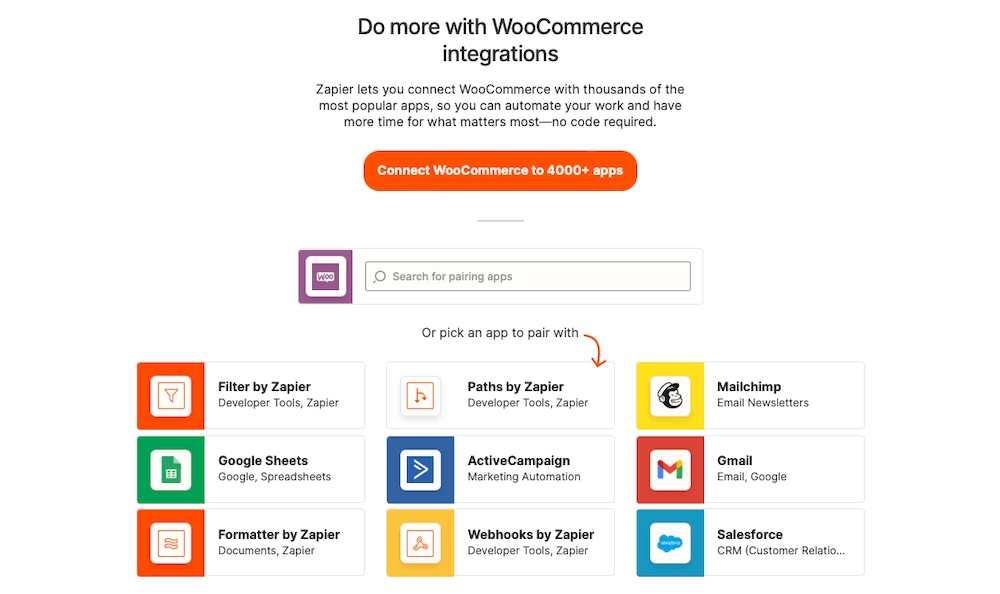
Zapier comes with many integrations and zaps. You can either pick apps to connect to yourself and set up the zap, or you can pick from popular zaps and instantly implement them.
After that Zapier will start automating the process without any further input needed.
Benefits of Using Zapier With WooCommerce
The biggest benefit of using Zapier with WooCommerce is that the automation saves time overall. When you’re not having to execute every single task across an entire workflow, you stand to save a lot of time and effort.
This is especially apparent with some tasks required to maintain your online store, such as updating product stock manually. This can get awfully tedious or even become impossible to keep up with when done line-by-line. Thankfully, there are zaps you can use to streamline this process and make it more hands-off.
A few other examples of how you could use Zapier with WooCommerce include:
- Configure Twitter to send a tweet when you add a new product page to your online store.
- Send an email to your customers when a product is low on stock.
- Connect to your stock tracking sheet and automatically update stock numbers when a new order is made.
- Add order info to Google Sheets automatically when a new order is made.
- Add new customers to your email marketing list on MailChimp or AWeber.
We’ll discuss even more specific examples of recipes you can use with WooCommerce in just a bit. But first, let’s talk about how to set up Zapier connections or zaps with WooCommerce in the first place.
How To Set Up WooCommerce Zapier Connections (Zaps)
Your first order of business is to make a Zapier account. Zapier is free for up to 100 tasks per month. You can also trial higher-level plans.
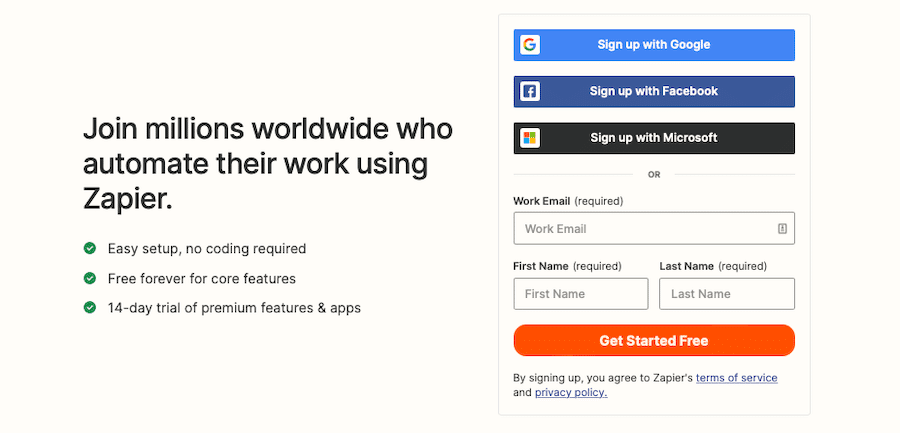
Just input your email address, first and last name, and then set a password. Alternatively, you can sign up using your Google, Facebook, or Microsoft credentials. Next, you can select which apps you use the most frequently to get customized zap suggestions. In this case, we input “WooCommerce,” and the dashboard presented as such:
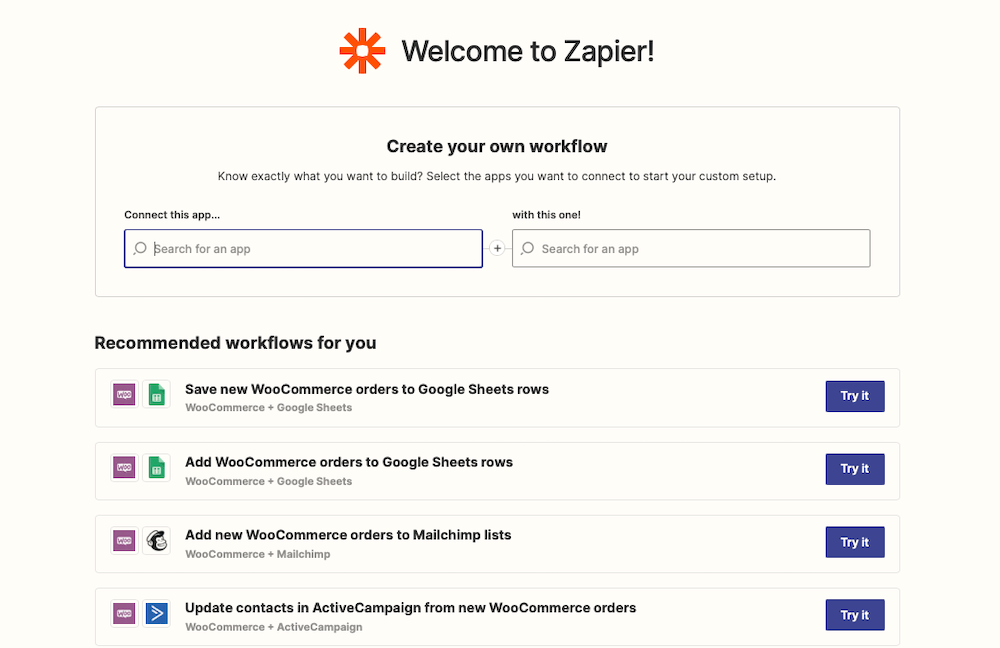
But before you can set up these workflows, you’ll need to configure WordPress to work with it.
How To Install the Zapier Plugin
There are a few ways to integrate Zapier with WordPress and WooCommerce.
First, there’s the WooCommerce Zapier plugin, which is a premium option and available from the official WooCommerce plugin and extensions store.
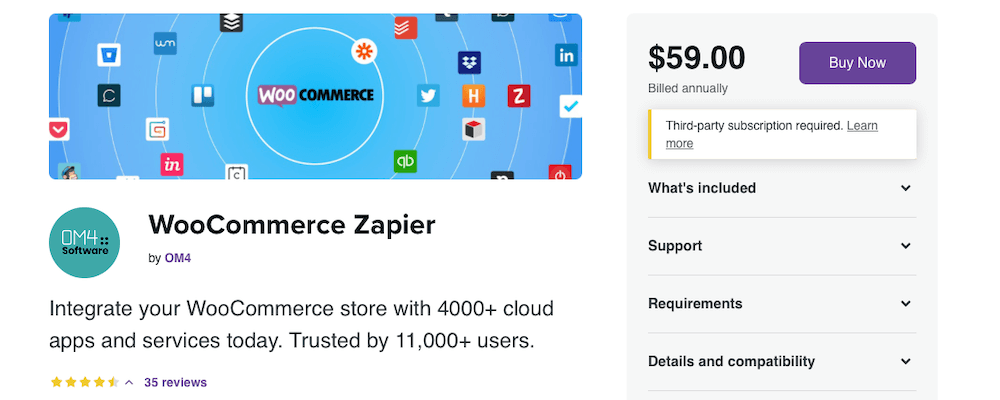
It offers full compatibility with all Zapier-connected apps and services. However, it does cost $59 per year. To install it, simply complete your purchase, download the WooCommerce plugin’s .zip file, and then upload it to WordPress as you would any other plugin by going to Plugins > Add New > Upload Plugin.

Another option is the WPFlyLeads plugin, which allows you to automatically send your leads gathered with WooCommerce over to Zapier.

The plugin is free but it relies on webhook, which is a feature of the premium version of Zapier.
Another plugin for connecting WooCommerce with Zapier is Uncanny Automator. It only integrates with certain plugins and extensions, however, but it is a free option that might serve your needs.

To install either of these two free plugins, simply go to Plugins > Add New in your WordPress dashboard then search for the plugin in question.
Next, go back to Zapier to establish a connection between WooCommerce and Zapier. Follow the guided walk-through to connect your WooCommerce store to Zapier.
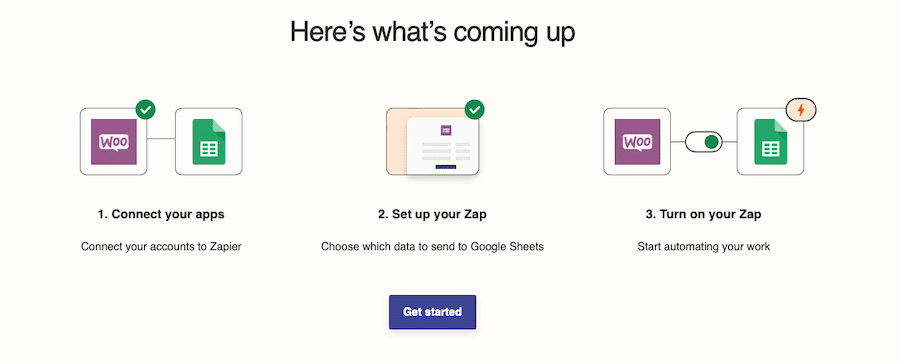
How To Set Up Triggers & Integrations
Before you begin creating triggers and establishing integrations between WooCommerce and other apps, you’ll need to install any plugins you want to integrate first.
For example, you could try installing WooCommerce Bookings to modify the checkout process if you run a service-based business. Or you could install Gravity Forms to integrate form processing with other external services. Anything else supported by your Zapier plugin of choice will suffice, too.
You can also use any of the functions that are available to you by default in WooCommerce, such as a new order being made. Speaking of, here’s an example of setting up a trigger using Zapier and WooCommerce. The integration we’ll be relying on here is Google Sheets.
The workflow we want to create is one where every new order is automatically added to a new row in a Google Sheets file you specify.
To create this, do the following:
1. Log in to your Zapier account. Click the + icon and then start to type in WooCommerce until the logo appears. Select it.
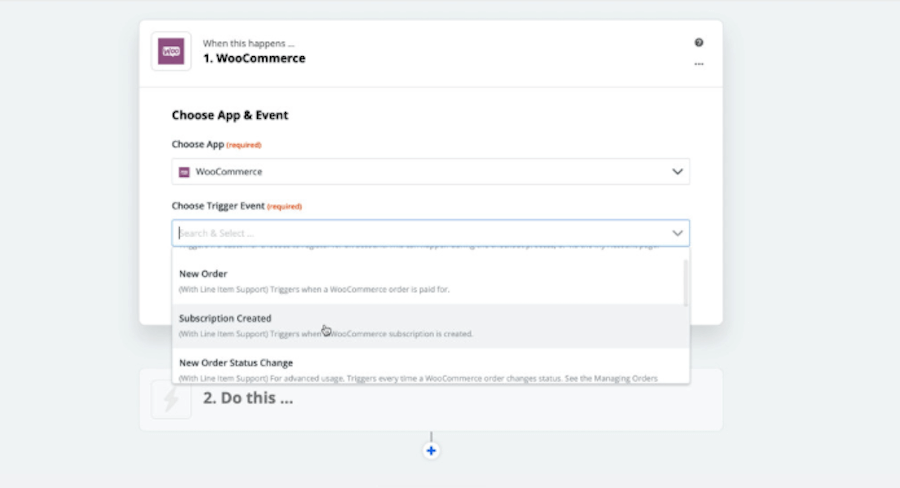
2. Pick the New Order trigger event. Then copy the webhook provided. Paste this webhook into the plugin of your choice to add the feed to your website.
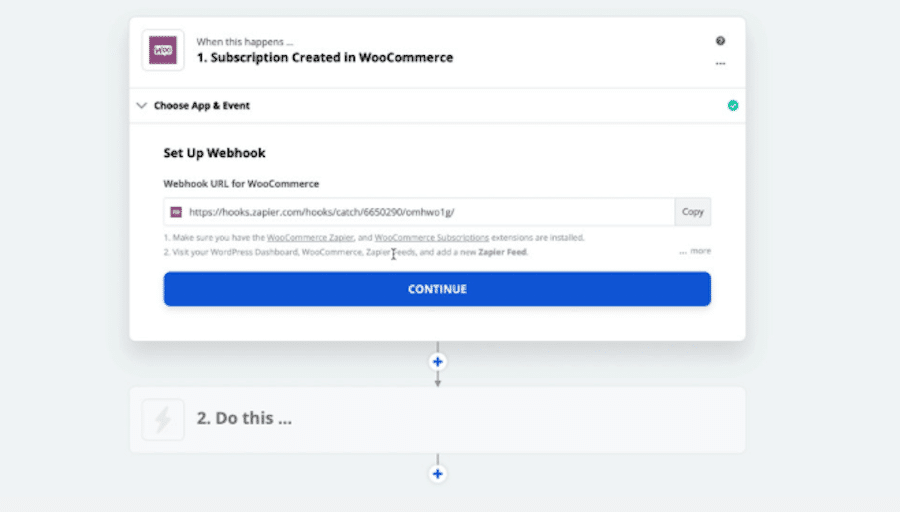
How To Create Zaps
Back in the zap editor, choose what should happen when the trigger goes off. Choose the sheets app and update the spreadsheet row.

Then lastly, use Zapier to run a test with a dummy order and see its info appears in Google Sheets as you’ve specified.
That’s all there is to it.
Top 12 WooCommerce Zapier Integrations & Recipes
With the setup out of the way, you can get down to simplifying your life as an online store owner. Here are 12 zaps that can save you a lot of time.
1. Add WooCommerce Orders to Google Sheets Rows
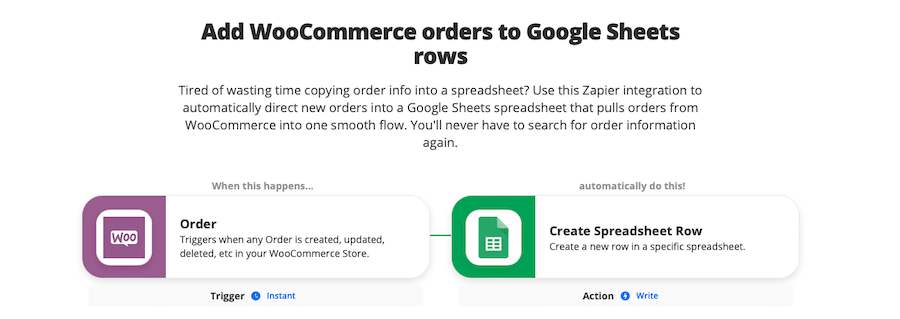
This WooCommerce integration for adding orders to Google Sheets rows could help your organizational efforts tremendously. Instead of having to manually copy and paste order information into a spreadsheet, you can configure this zap to complete this procedure for you.
It works by automatically adding new orders directly into a Google Sheets file. New order comes in, Zapier gets to work, and the info is added to the spreadsheet immediately.
2. Reward New WooCommerce Orders with Unique Coupons Through Coupon Carrier
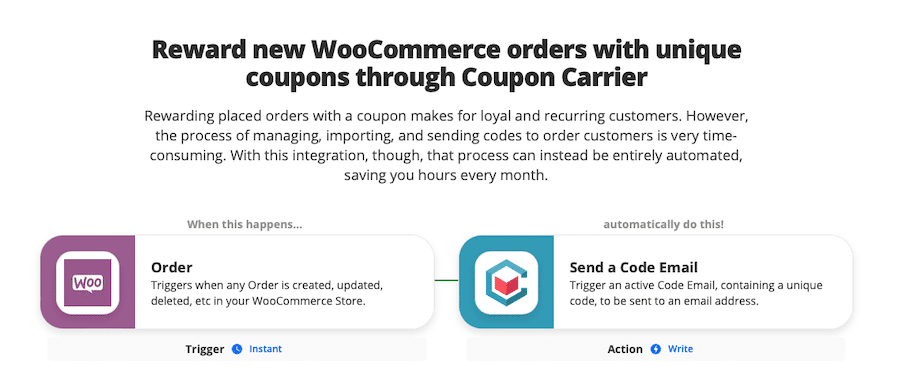
Another integration worth checking out is this one, which allows you to easily reward customers who make new WooCommerce orders with a unique coupon via Coupon Carrier. When a customer makes an order, they will be given a coupon immediately to thank them for their purchase.
This is a fantastic way to build a reputation as a thoughtful seller and it also can help to create loyal customers.
By automating the workflow of creating a new coupon for each new order and sending it to customers, you stand to save time without sacrificing customer appreciation.
3. Capture New WooCommerce Customers as Marketo Leads
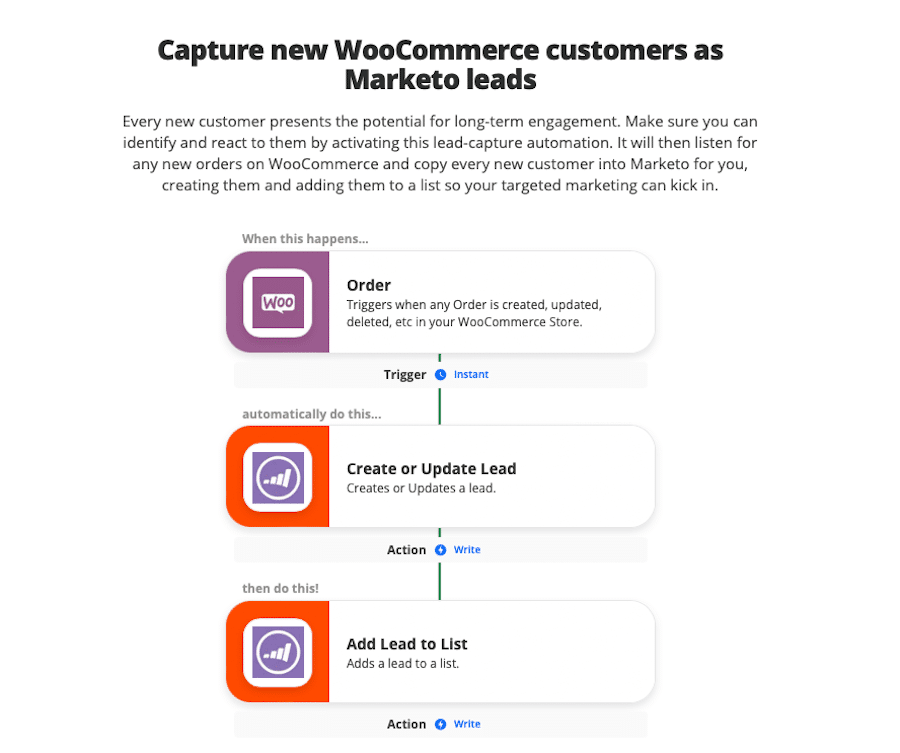
If you’re wanting to extend the relationship with your customers, you can use this Zapier integration, which automatically inserts new WooCommerce customers into Marketo for you. It’s an effective lead capture automation that takes new orders from WooCommerce and copies each new customer over to Marketo on your behalf.
If also adds them to your marketing list so they’ll be added to any automated email campaigns you currently have going.
4. Create Trustpilot Invitations from New WooCommerce Orders
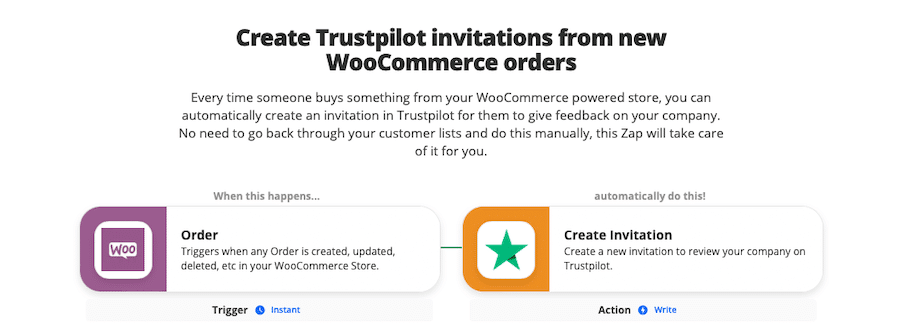
Or, you can use this integration to turn new WooCommerce orders into Trustpilot invitations. So, any time someone makes a purchase from your WooCommerce store, they will be sent an invitation from Trustpilot requesting that they leave feedback about your company.
It’s time-consuming to have to go through your orders list to send these out manually, so having the process automated will ensure you don’t spend extra time you don’t need to on the task and that you won’t accidentally forget to do it.
5. Add New WooCommerce Customers to ActiveCampaign
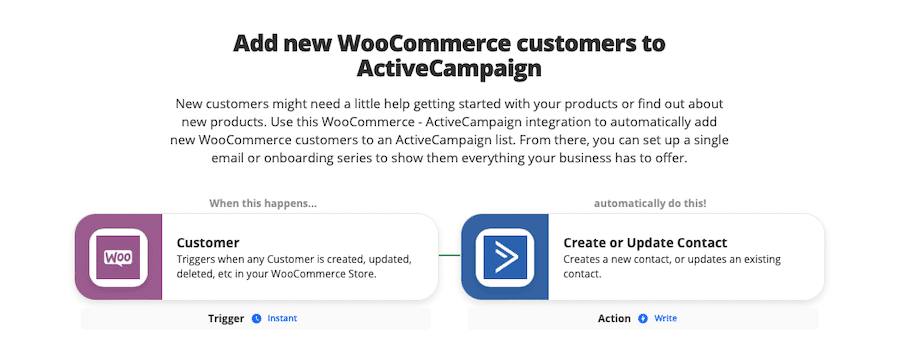
Another useful integration to consider using is this one, which allows you to add new WooCommerce customers to ActiveCampaign.
This is especially helpful if your product or service has a learning curve or if customers could benefit from getting started guides. You can even use this to add customers to a list for future product announcements to aid with customer retention.
6. Save New WooCommerce Clients to HubSpot Contacts
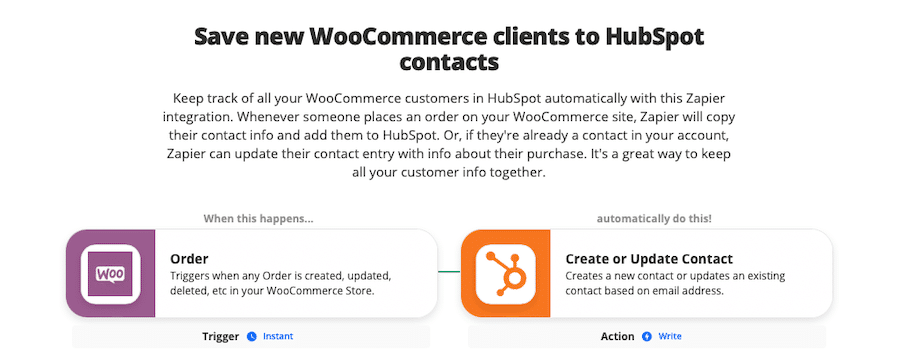
If you’re a fan of HubSpot, this integration lets you save new WooCommerce clients into your HubSpot contacts, which is pretty useful. Whenever a new customer makes an order from your WooCommerce store, their contact information is added directly to HubSpot to be used within your campaigns.
What’s extra helpful is that the integration will also update a customer’s information with a new purchase if they’ve bought from you in the past. This makes it simple to keep all order info – past and present – organized and in one location.
7. Create QuickBooks Online Sales Receipts for New WooCommerce Orders
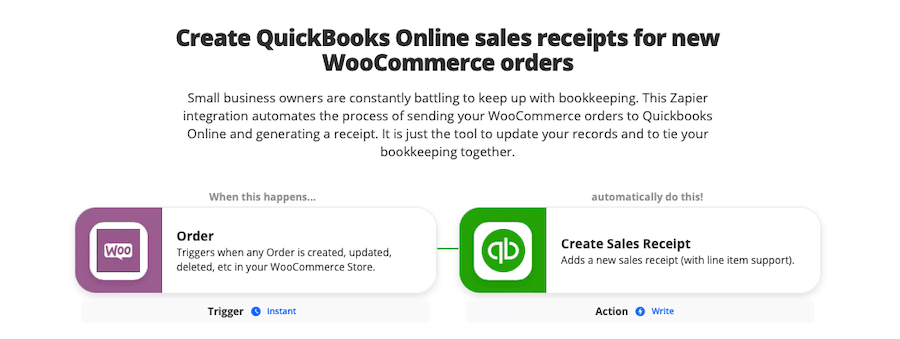
Another useful integration is to automatically create a QuickBooks Online sales receipt for each new WooCommerce order. So, instead of having to update your bookkeeping records manually, this zap takes care of it for you automatically.
8. Create Trello Cards from New WooCommerce Orders
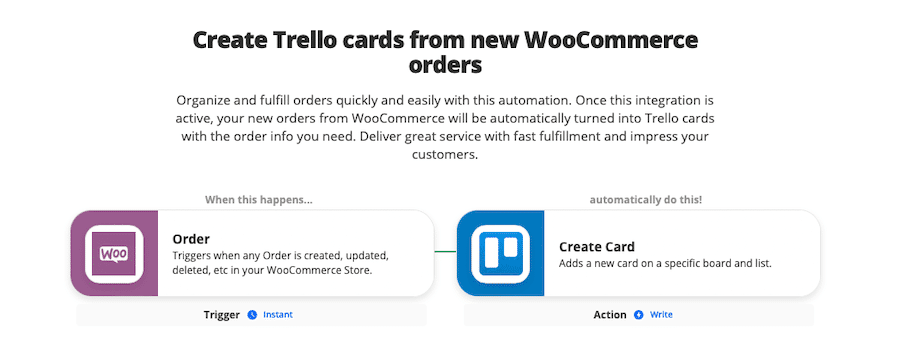
If you struggle with organization, making it so a new Trello Card is automatically created each time you get a new WooCommerce order could be helpful. The automatically generated Trello cards contain the order information you need to complete it.
This is especially helpful if your store sells products with customizations. A Trello card with the custom details will help ensure your customers get exactly what they ordered every time.
9. Create Tookan Delivery Tasks for New WooCommerce Orders
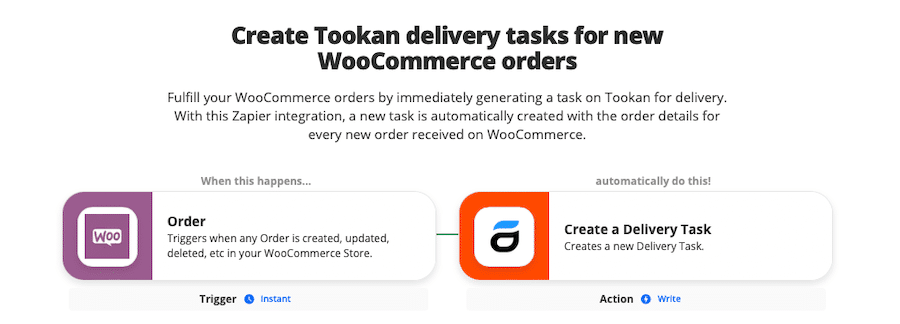
Or perhaps you could make use of this integration, which creates a Tookan delivery task for each new WooCommerce order. The new task in Tookan is automatically generated after an order is placed and includes all relevant order details.
10. Get Scheduled Summaries of WooCommerce Orders Delivered to Gmail
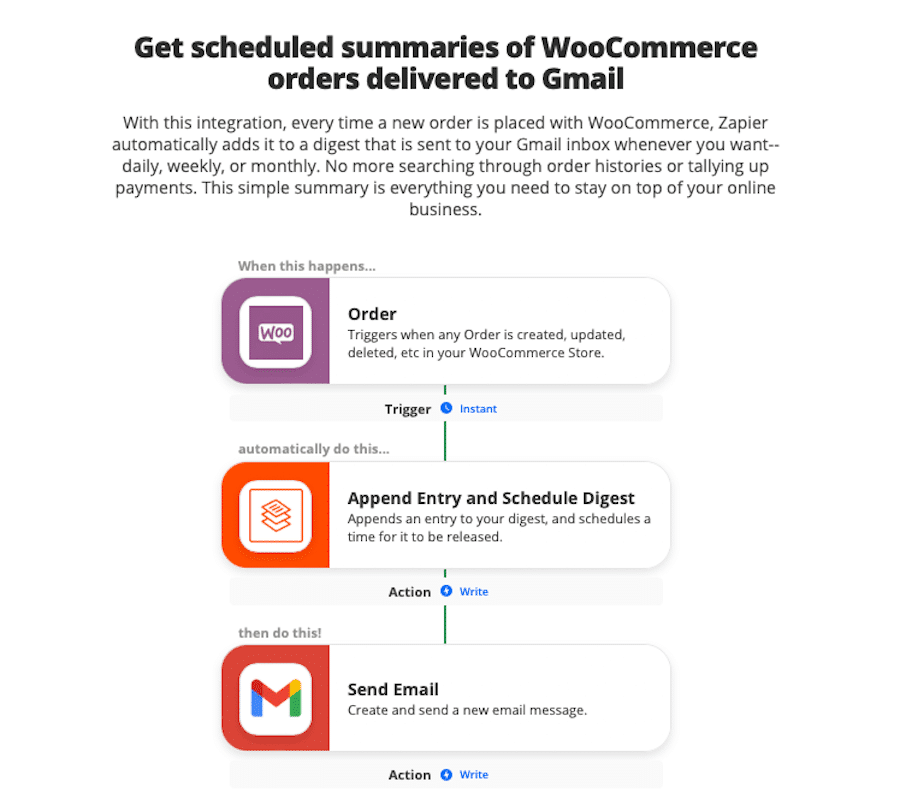
If you live in your email inbox, receiving summaries of your latest WooCommerce orders delivered to your Gmail address could be helpful and keep you better informed about the state of your store.
Once this zap is activated, you’ll be notified via email each time a new order is placed. You can set the frequency of these emails as well, and the zap will compile and send a digest of all orders daily, weekly, or monthly. This way you’ll always know where your business stands, no matter where you are.
11. Send an SMS to Your Customers When Their WooCommerce Order Changes Status

Some Zapier integrations help keep customers in the know about their orders, too. This one sends an SMS to a customer when their order changes status.
This way, customers will be automatically notified when their order is confirmed or shipped without you having to send out anything manually. This is a great way to keep customers informed and for building consumer trust.
12. Add Leads to Salesforce from New WooCommerce Orders

Last on our list here is an integration that adds leads to Salesforce whenever you receive a new WooCommerce order. There’s no need to export your customer list manually or anything like that. Instead, this zap will import new customers into Salesforce the moment they place an order from your WooCommerce store.
These customers are then listed as new leads in Salesforce, which you can then contact or add to your email marketing campaigns as you see fit.
Summary
And that’s it! Hopefully, you now have a better understanding of how to integrate WooCommerce with Zapier. We spent time today talking about what Zapier is, how it works with WooCommerce, as well as the benefits of using it with WooCommerce.
We also detailed the process of setting up Zapier connections or “zaps,” including the plugins you need and the steps required to integrate Zapier with WooCommerce, as well as integrating other apps within Zapier. We also talked about setting up triggers and integrations and offered a healthy list of zaps you can put to work with WooCommerce right away.
Now’s the time to get to work streamlining and simplifying your workflows. And Zapier + WooCommerce is a powerful combo to achieve just that. If you still have questions about online stores in general, be sure to read our comprehensive guide to boosting sales with WooCommerce, too.


